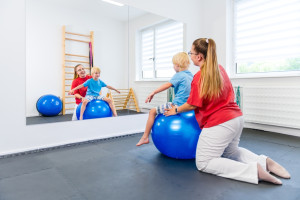More and more health resorts are closing. This is the reality of Polish sanatoriums.

- The trend of doctors not referring children to health resorts and parents not sending them for health resort treatment has been increasing for several years, leading to the closure of further departments
- This is to be prevented by a pilot project aimed at testing solutions that involve direct qualification and referral of children for spa treatment, bypassing the National Health Fund.
- The National Health Fund (NFZ) doesn't prevent children from visiting health resorts. Quite the opposite.
- We did this work at the grassroots level, but the effect was short-lived – says Marcin Zajączkowski from the Ciechocinek Spa.
The number of children referred to spas is decreasing year by year. According to data for 2024, only 6,700 patients aged 3-18 received spa treatment. This represents just 1.6% of those treated in spas last year and less than half of the children who were referred to spas in 2018, when there were 16,000.
The trend of doctors not referring children to spas and parents not sending them for spa treatment has been deepening for several years, leading to the closure of more and more hospitals . Due to the decreasing number of referrals and the significant seasonality of children's stays (holidays) and the resulting lack of balance, children's hospitals and sanatoriums in Kołobrzeg, Krasnobród, Szczawno-Zdrój, Szczawnica, Dąbki ("Argentyt" Spa Sanatorium), and Rabka (sanatorium ward for children aged 3-6) have closed in recent years.
Spa treatment for children is currently provided by 10 entities in 6 spa towns in Ciechocinek, Dąbki, Goczałkowice-Zdrój, Kudowa-Zdrój, Rabka-Zdrój and Rymanów-Zdrój.
"The National Health Fund does not block children from places in health resorts""This is the final straw: either appropriate decisions are made, or all the facilities that are still operating will be closed. This is a huge potential that will be very difficult to rebuild," warned Aleksandra Siedzik, national consultant in the field of balneology and physical medicine, at a meeting of the Parliamentary Group for Supporting the Development of Spas and Spa Municipalities.
The proposed pilot program aims to prevent this by testing solutions that directly qualify and refer patients for spa treatment . Each pediatric e-referral for inpatient spa treatment would not be subject to the National Health Fund's qualification process, but would instead be released directly into the general public.
The pilot program would cover two inpatient services dedicated to children and youth: inpatient spa treatment for children aged 3-18 and adult-supervised spa treatment for children aged 3-6. The application to launch the pilot program was submitted to the Ministry of Health in May of this year.
Barbara Jabłońska , Deputy Director of the Department of Uniformed Services at the National Health Fund Headquarters, addressed the issue of changes in the way children are referred to spas . She emphasized that the National Health Fund is not blocking children from spas.
"Quite the opposite is true. The Fund has repeatedly contacted all institutions, primary care physicians, provincial consultants, and scientific societies, requesting referrals to children's health resorts. Unfortunately, these referrals are in short supply. However, all referrals submitted to the National Health Fund are 100 percent confirmed," she assured.
"Whether the child will actually make it to the spa is a completely different matter. Parents often decide to cancel because the date or location of the trip don't suit them, or they simply don't see the need for their child to go for spa treatment. Unfortunately, the National Health Fund (NFZ) has no influence on this and cannot be held responsible. The main cause of the problem is the lack of referrals for spa treatment for children and the lack of interest from parents in having their children treated at spas," Director Jabłońska pointed out.
She added that the Fund purchases places for children in spas every year. Each year, it buys fewer places because the number of referrals issued for children continues to decline. Despite this, the same number of places were purchased in 2025 as last year, because the payer hoped that discussions with the medical community would stem the negative trends. The National Health Fund (NFZ) is unable to do anything more.
"We have a reverse snowball effect"Aleksandra Siedzik emphasized that she never claimed that the National Health Fund was blocking the sending of children to health resorts.
- However, the waiting list is managed centrally and therefore the Fund cannot refer a child out of turn to a center located close to the place of residence if – according to the order – a place is waiting at the other end of Poland - she explained.
Marcin Zajączkowski, president of the management board of Uzdrowisko Ciechocinek SA, assessed that if children's health resorts were not owned by local governments or the State Treasury, children's health resort treatment would no longer exist.
"Thanks to the decision of the Kuyavian-Pomeranian Voivodeship government, which approved the proposal to allocate a significant portion of our spa hospital to the needs of adults, we no longer have to close. We have retained a 70-bed ward for children and 100 beds for adults . This is the only solution, as we have struggled to sustain losses of around PLN 2 million over the years. This has impacted the operation of the entire spa," President Zajączkowski pointed out.
"Before the decision was made to reorganize the spa hospital, we tried to encourage children to undergo spa treatment. We visited the entire province: schools, orphanages, pediatric hospitals. There was an effect, but only temporarily. Then everything returned to "normal." Currently, we're experiencing a reverse snowball effect, which, the further it rolls, the less it decreases. After all, the National Health Fund contracts services for a given year based on services provided in the previous year. And there are fewer and fewer of those," said the president of the management board of Ciechocinek Spa.
"Therefore, it's not actions like encouraging referrals that can save pediatric spa treatment, but systemic changes. This is the last moment," he warned.
Working at the grassroots level is not enoughBarbara Jabłońska from the National Health Fund (NFZ) assessed that even if the grassroots efforts undertaken by the Ciechocinek Spa have yielded only temporary results, it seems that other spas should also undertake these initiatives before a decision is made to launch a pilot program. The Fund has long been encouraging such grassroots efforts.
- It is also worth noting that changing the way children are directed to health resorts without using the Fund will require a change in the law, and implementing the pilot program means the need to allocate additional funds for this purpose - she added.
Aleksandra Sądek pointed out that the pilot project indicates the need for many changes, not just in the management method . These would include, among other things, the organization of spa treatment for children, which is currently archaic, for example, in terms of a single, mandatory treatment time. Certainly, some flexibility should be introduced here.
"It's also about the way rehabilitation services are delivered, which children's health resorts should strongly emphasize. Until now, the way services are delivered in different health resorts has varied greatly: some professionally, others not. This could be one of the reasons discouraging doctors and parents from referring and sending children to health resorts. Now we need to change this. Let the results of treatment at the health resort speak for themselves," said the national consultant.
Copyrighted material - reprint rules are specified in the regulations .
rynekzdrowia













